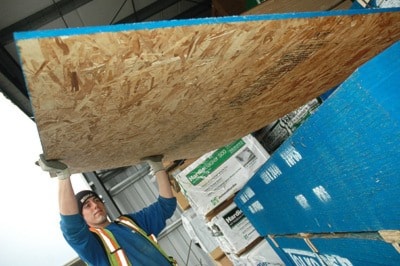A $2.2-million engineered-wood pilot project has landed in Chemainus to test gear for making value-added goods at less cost, a spokesman says.
StrongWood Technologies is using Mural Town’s test results as it weighs the potential for a multi-million-dollar plant that would be mostly used for making housing materials out of hemlock.
But Strongwood’s David Parker stressed no decisions have been made about where, or even if, the plant will be built,
The Chemainus-Ladysmith area, Campbell River, Port Alberni and the upper Lower Mainland could be potential candidates given financing, wood access, markets, workers and more, he said.
“This is a pilot-plant lay-up, not a pilot plant,” Parker said. “Folks with the money will say where the plant goes.”
StrongWood’s possible 100,000-square-foot plant on 25-odd acres would make an array of wood products spanning glue-laminated timbers, laminated-veneer lumber, and oriented strand board (OSB).
“We can make engineered lumber at at least 20 per cent less cost than other engineered products,” Parker told the News Leader Pictorial. “That should assist engineered products to penetrate the market, but we don’t have a plant yet.”
That points to the importance of ongoing Mural Town’s tests which are employing a handful of workers.
“In Chemainus, we’ve had equipment manufactured and we’re testing it during the next three months,” he said last week. “This week, we’ll turn over the machinery and make sure it runs.”
Tests are 80 per cent taxpayer funded, with money from Ottawa and Victoria, Parker said.
The other 20 per cent came from StrongWood’s four corporate partners: WFP, which provided the pilot’s 2,500-square-foot building; veneer maker Raute Canada; scanning-gear maker Microtec; and OSB maker Ainsworth Engineering.
WFP — perhaps the world’s largest supplier of hemlock — doesn’t make laminated products currently, and wants to be part of the action.
“WFP supports this project and we were able to support it on our (Chemainus) site,” said WFP’s Gary Ley. “We’re always interested in identifying new markets.
“It’s all about seeing if it works and potential use of hemlock, which we have lots of.”
Transportation tabs, market conditions, labour skills, and fuel costs will be key in deciding where the plant, employing perhaps 200, would be built, Parker said.
Geoff Millar, Cowichan’s economic development manager, aims to make sure our region’s name is in the hat.
He stacked the importance of boosting local jobs, green sustainability and value-added goods against raw-log exports.
“We definitely want to be in the mix for consideration.”
Noted Parker: “If we don’t get financing and a site selected by the end of 2012, we probably won’t get one built.”
But if tests and other factors align “we think there’s potential for (engineered-wood) plants in the south and west U.S., the Interior, Eastern Canada, and coastal B.C.,” Parker said.
He hoped the local tests show products can be made using more of each log, with limited waste.
“Our trim loss is two per cent rather than 15 per cent for other engineered products.
“We’re also able to match market requests to our manufacturing process,” Parker said, touting efficient sawing patterns.
Streamlining could spell economic and environmental benefits, Parker postulated.
“This could revitalize the wood industry on the coast.”
